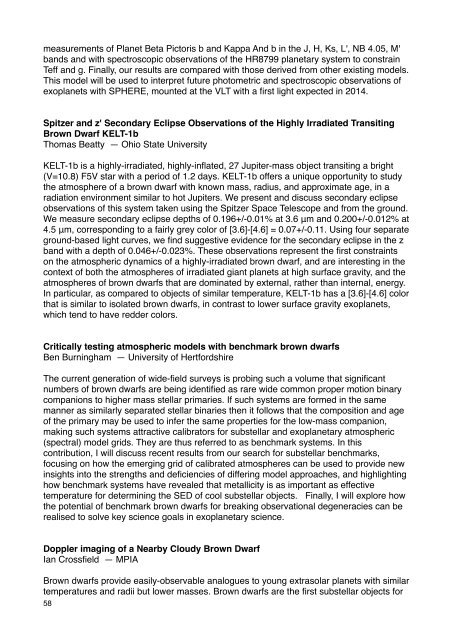Exoclimes_Conference_booklet1
Exoclimes_Conference_booklet1
Exoclimes_Conference_booklet1
You also want an ePaper? Increase the reach of your titles
YUMPU automatically turns print PDFs into web optimized ePapers that Google loves.
measurements of Planet Beta Pictoris b and Kappa And b in the J, H, Ks, L', NB 4.05, M'<br />
bands and with spectroscopic observations of the HR8799 planetary system to constrain<br />
Teff and g. Finally, our results are compared with those derived from other existing models.<br />
This model will be used to interpret future photometric and spectroscopic observations of<br />
exoplanets with SPHERE, mounted at the VLT with a first light expected in 2014.<br />
Spitzer and z' Secondary Eclipse Observations of the Highly Irradiated Transiting<br />
Brown Dwarf KELT-1b!<br />
Thomas Beatty — Ohio State University!<br />
KELT-1b is a highly-irradiated, highly-inflated, 27 Jupiter-mass object transiting a bright<br />
(V=10.8) F5V star with a period of 1.2 days. KELT-1b offers a unique opportunity to study<br />
the atmosphere of a brown dwarf with known mass, radius, and approximate age, in a<br />
radiation environment similar to hot Jupiters. We present and discuss secondary eclipse<br />
observations of this system taken using the Spitzer Space Telescope and from the ground.<br />
We measure secondary eclipse depths of 0.196+/-0.01% at 3.6 μm and 0.200+/-0.012% at<br />
4.5 μm, corresponding to a fairly grey color of [3.6]-[4.6] = 0.07+/-0.11. Using four separate<br />
ground-based light curves, we find suggestive evidence for the secondary eclipse in the z<br />
band with a depth of 0.046+/-0.023%. These observations represent the first constraints<br />
on the atmospheric dynamics of a highly-irradiated brown dwarf, and are interesting in the<br />
context of both the atmospheres of irradiated giant planets at high surface gravity, and the<br />
atmospheres of brown dwarfs that are dominated by external, rather than internal, energy.<br />
In particular, as compared to objects of similar temperature, KELT-1b has a [3.6]-[4.6] color<br />
that is similar to isolated brown dwarfs, in contrast to lower surface gravity exoplanets,<br />
which tend to have redder colors.<br />
Critically testing atmospheric models with benchmark brown dwarfs<br />
Ben Burningham — University of Hertfordshire<br />
The current generation of wide-field surveys is probing such a volume that significant<br />
numbers of brown dwarfs are being identified as rare wide common proper motion binary<br />
companions to higher mass stellar primaries. If such systems are formed in the same<br />
manner as similarly separated stellar binaries then it follows that the composition and age<br />
of the primary may be used to infer the same properties for the low-mass companion,<br />
making such systems attractive calibrators for substellar and exoplanetary atmospheric<br />
(spectral) model grids. They are thus referred to as benchmark systems. In this<br />
contribution, I will discuss recent results from our search for substellar benchmarks,<br />
focusing on how the emerging grid of calibrated atmospheres can be used to provide new<br />
insights into the strengths and deficiencies of differing model approaches, and highlighting<br />
how benchmark systems have revealed that metallicity is as important as effective<br />
temperature for determining the SED of cool substellar objects. Finally, I will explore how<br />
the potential of benchmark brown dwarfs for breaking observational degeneracies can be<br />
realised to solve key science goals in exoplanetary science.<br />
Doppler imaging of a Nearby Cloudy Brown Dwarf<br />
Ian Crossfield — MPIA<br />
Brown dwarfs provide easily-observable analogues to young extrasolar planets with similar<br />
temperatures and radii but lower masses. Brown dwarfs are the first substellar objects for<br />
58


